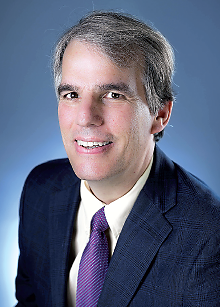Study Finds Overall Increase in Youth Prescribed Antipsychotics
Abstract
Antipsychotic use increased from 2006 to 2010 for adolescents and young adults but not for children aged 12 years or younger.
Though issues surrounding antipsychotic use among youth within state foster care systems and Medicaid programs continue to gain much attention (Psychiatric News, July 3), little is known about the overall patterns and trends of such use by young people in the general population.

Mark Olfson, M.D, M.P.H., believes that current treatment patterns for antipsychotic use in youth indicate that too many young children are being treated without clinical expertise from a child and adolescent psychiatrist.
Mark Olfson, M.D., M.P.H., a professor of psychiatry at Columbia University Medical Center and research psychiatrist at New York State Psychiatric Institute, led an investigation of prescription records of over 2.5 million youth aged
1 to 24 to determine patterns and trends in antipsychotic prescriptions for young people in the United States.
“There is widespread concern over the extent to which young people are treated with antipsychotic medications for conditions outside of their FDA-approved clinical indications,” Olfson told Psychiatric News. “We sought to identify which groups were most likely to be treated with antipsychotic medications and to learn about the clinical context of this treatment.”
Data for antipsychotic prescriptions filled in 2006, 2008, and 2010 were retrieved from the IMS LifeLink LRx Longitudinal Prescription database, which includes data from about 60 percent of all retail pharmacies within the United States. The researchers then calculated the percentage of young people for whom one or more antipsychotic prescriptions were filled during the study year by sex and age group and generalized the IMS prevalence to the entire U.S. population of young people, including those who did not fill a prescription. The sample size was divided into four categories: younger children (1 to 6 years), older children (7 to 12 years), adolescents (13 to 18 years), and young adults (19 to 24 years).
In addition to analyzing usage rates among this population, Olfson and colleagues measured the prevalence of specific clinical psychiatric diagnoses, as well as the rates for having at least one or more antipsychotics prescribed by a psychiatrist or child and adolescent psychiatrist.
“We found that boys and adolescent males between ages 11 and 17 [in 2010] had the highest rates of antipsychotic treatment and that these young people were often clinically diagnosed with attention-deficit/hyperactivity disorder (ADHD) and also treated with stimulants,” said Olfson. In fact, ADHD was the most common diagnosis among children and adolescents treated with antipsychotics.
“These patterns are consistent with the view that antipsychotic medications are commonly used to help manage impulsive aggression and other behavioral symptoms that are commonly associated with ADHD, especially in boys,” he said.
The researchers also observed an uptick in the percentage of adolescents and young adults whose antipsychotic prescriptions were filled in 2006 and 2010, with rates, respectively, being 1.10 percent and 1.19 percent for adolescents, and 0.69 percent and 0.84 percent for young adults.
In contrast, the rates declined in children: In 2006 and 2010, respectively, the rates for younger children were 0.14 percent and 0.11 percent, and 0.85 percent and 0.80 percent for older children.
Among young people whose antipsychotic prescriptions were filled in 2010, receiving a prescription from a psychiatrist was less common among younger children (57.9 percent) than among other age groups (range, 70.4 to 77.9 percent). Fewer than half of the studied population with a prescription for antipsychotics in 2010 had any medical visit that included a mental health diagnosis.
“Psychiatrists, especially those who treat young children, should reach out and work to establish strong referral relationships with pediatricians and other primary care physicians who treat young children,” Olfson said. “Because these medications should be used only in young children when there is severe, sustained, and intractable impairment in several areas of functioning or real safety risks, these youth should be under the care of a child psychiatrist whenever possible.”
Olfson said that it would be helpful for psychiatric researchers to identify and study models of care that successfully integrate child and adolescent mental health services into pediatric primary care. Such integration might increase early access to specialty mental health care and reduce the unnecessary use of antipsychotic medications for children with nonpsychotic psychiatric disorders, he said.
Though progress has been made on developing psychosocial and psychotherapeutic treatments for disruptive behaviors in youth, Olfson noted that such interventions are not widely available. Studies show that less than a quarter of antipsychotic-treated young people received any psychotherapy. Increasing access to psychosocial and psychotherapeutic interventions could help further reduce the use of antipsychotics among youth.
The study was funded by the National Institute on Mental Health and New York State Psychiatric Institute. ■
“Treatment of Young People With Antipsychotic Medications in the United States” can be accessed here.



